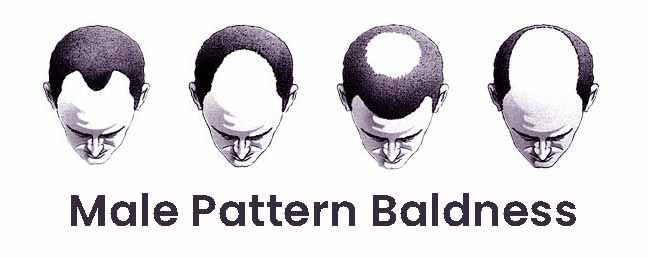Male Pattern Baldness: Causes, Symptoms, and Prevention
46 months ago
4 minute read.

Hair fall is a general issue that a lot of people face at various points in their life. Lifestyle, water quality mental health could be contributing factors to this loss. In general, this pattern is usually cyclical in nature where hair loss is followed by regrowth. In male individuals, the cyclical nature of the patterns changes, and the hair stops growing after a certain age. This pattern of baldness in male individuals is known as androgenic alopecia. The beginning of male pattern baldness could start as early as in the teenage years. While there can be wide-ranging reasons behind this condition ranging from hormone to something like poor diet, studies have shown that more than 85% of men are likely to undergo alopecia in their lifetime.
Male pattern baldness symptoms
One of the first things to look out for if you think you are experiencing male pattern baldness is to see whether any kind of regrowth is happening. Since alopecia is a form of baldness, there are very few chances of the lost hair growing back.

- The beginning of the condition can be marked by the loss of hair around the temples or the crown of the head.
- Some men tend to develop a single bald spot while others experience receding hairlines.
- Loss of hair is also noticed at the top of the head. This, however, happens at a much slower rate than the loss in areas such as around the temple.
Causes of Hair fall
Genetics and family history:
Genes are generally responsible for determining how your hair responds to the DHT hormone. This hormone is responsible for shrinking your hair follicles. If your follicle is sensitive to DHT it will affect the growth of any new hair by making them smaller, finer, or thinner. Eventually, they often reduce any newer growth leading to complete baldness. Male individuals who have a genetic vulnerability to alopecia might find themselves to be experiencing the symptoms at an age as early as their teenage years.
Health and hormones:
As opposed to popular belief, hormonal imbalance is a significant contributing factor to hair fall in men. The hormone responsible for this is testosterone. The hair follicles contain enzymes called 5 alpha-reductase, which converts testosterone into dihydrotestosterone (DHT). DHT is an androgen that is one of the most common contributing factors to male pattern baldness and even premature baldness.
Medication, radiation, and supplements:
With age, various kinds of medical complications start emerging within our body that requires certain kinds of medications and treatments that might have implications and side effects. Drugs used for the treatment of cancer, arthritis, heart problems or high blood pressure can, as a side effect, cause hair loss. Radiation therapy and chemotherapy can also cause hair loss and male pattern baldness.
Diet and nutrition:
Our body functions on cell regeneration. The process of regeneration becomes a lot more demanding as we age. For this, we need to maintain a diet rich in nutrients. However, a diet high in fat or sal might cause kidney issues or create acidic blood which can contribute to hair loss. Lack of nutrients in the body makes the body respond to it by economizing the available nutrients to forcibly make the hair fibers remain in the resting phase. This restricts growth and hair shedding. This cause can, however, be reversed by ensuring a better more nutritive diet.
Haircare routine:
Lack of hair care can result in male pattern baldness. The use of strong chemicals or extensive hot oil treatment can damage the roots and affect the hair fiber.
Prevention Tips
As we know by now, various factors can contribute to male pattern baldness and while genetic alopecia can hardly be avoided, other reasons can be combated by the following tips:
- Prevent pulling out hair: Choose your comb wisely. If you have thick hair or hair type that easily tangles, use a brush to gently comb them out. Be gentle when you dry your hair with a towel, the hair is at its weakest when it is wet. Also, avoid putting too many chemicals on your hair and scalp.
- If you are on any medication, ask your doctor about the side effects of the drug prescribed to you. Get more information about it and ask what can be done to limit these side effects.
- Smoking can, among the many harmful effects, cause baldness. Quit smoking at the earliest for all the obvious reasons.
- People undergoing chemotherapy can take the help of a cooling cap. These caps can protect you from the risk of losing hair.
Conclusion
Hair loss can be a cause of distress and loss of confidence. Understanding the underlying reason behind the issue is important to figure out what can be done to avoid it. Some factors are unavoidable but fret not, treatments like hair transplants and the use of wigs can be your savior any day.
Leave a Comment
Related Articles
Health Checks @ Home
Service
Explore
© 2025 Truworth Health Technologies Pvt. Ltd.





